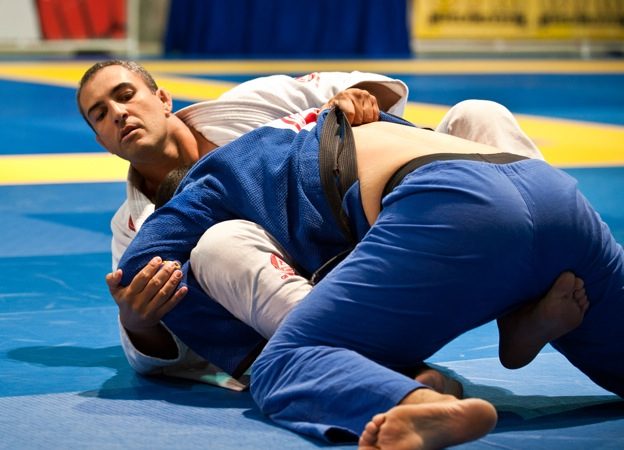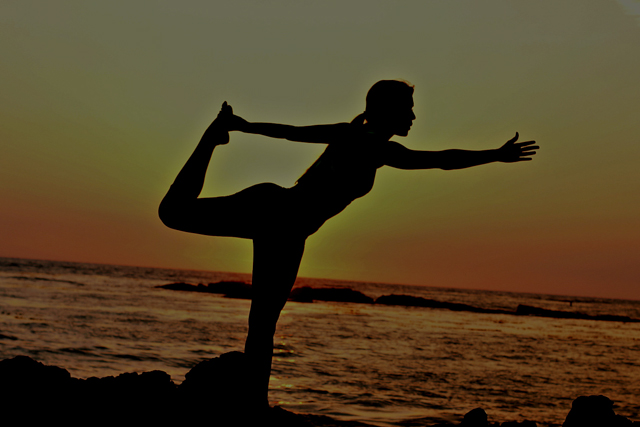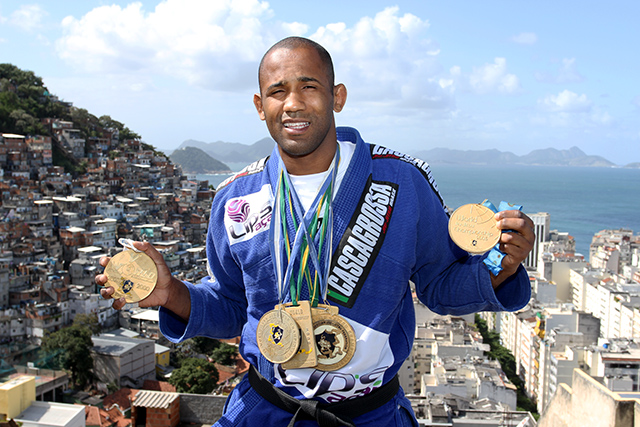[First published in 2009.]
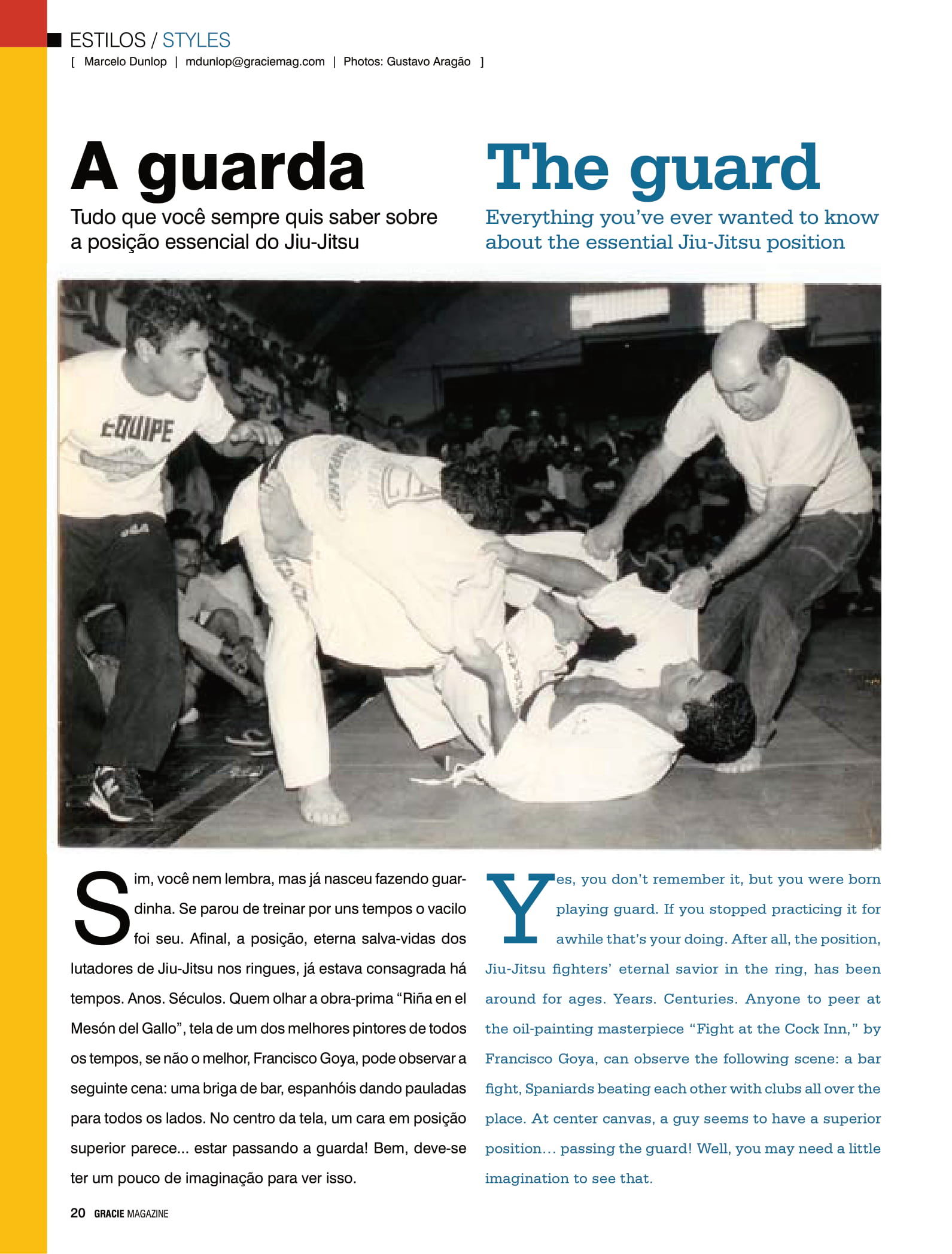
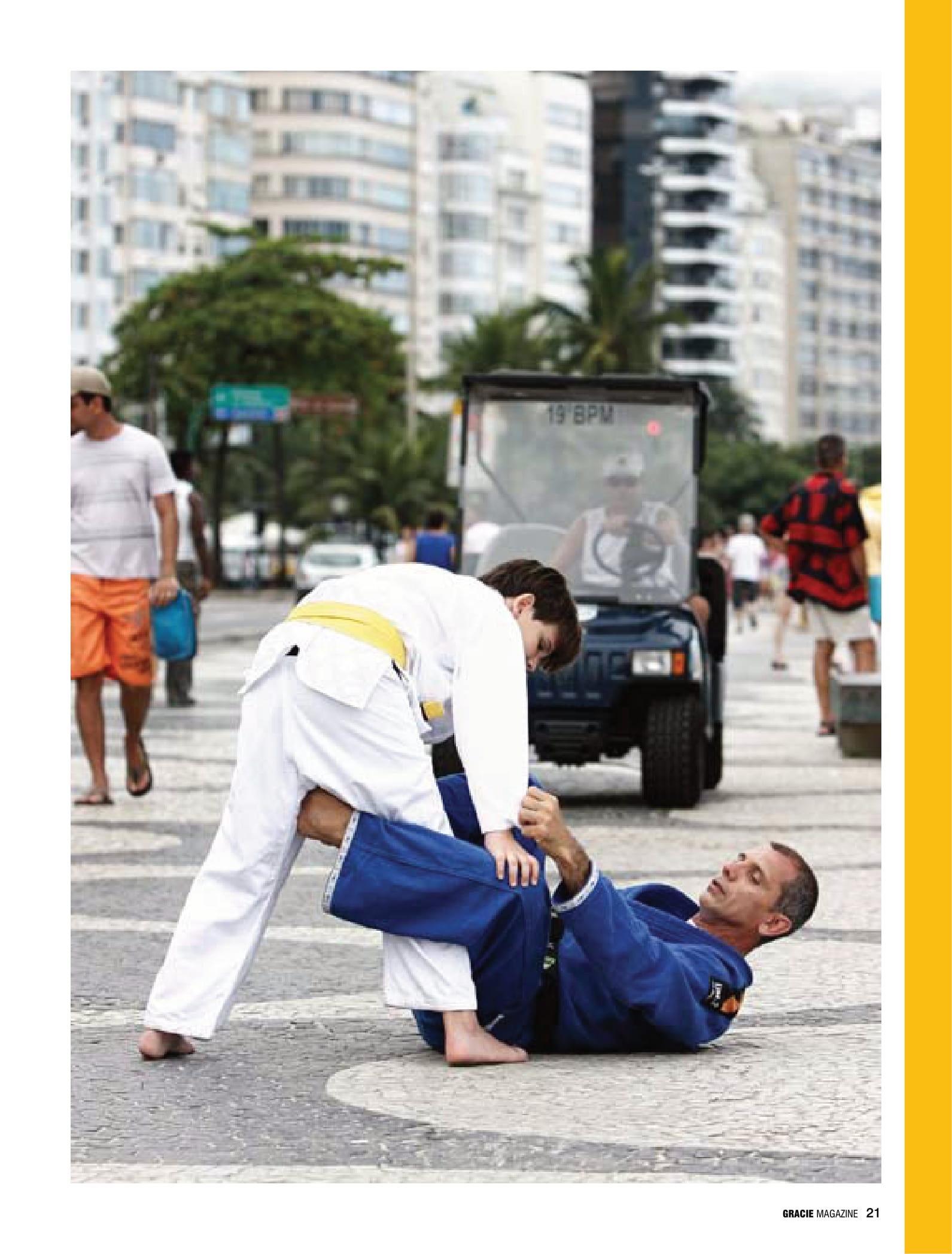
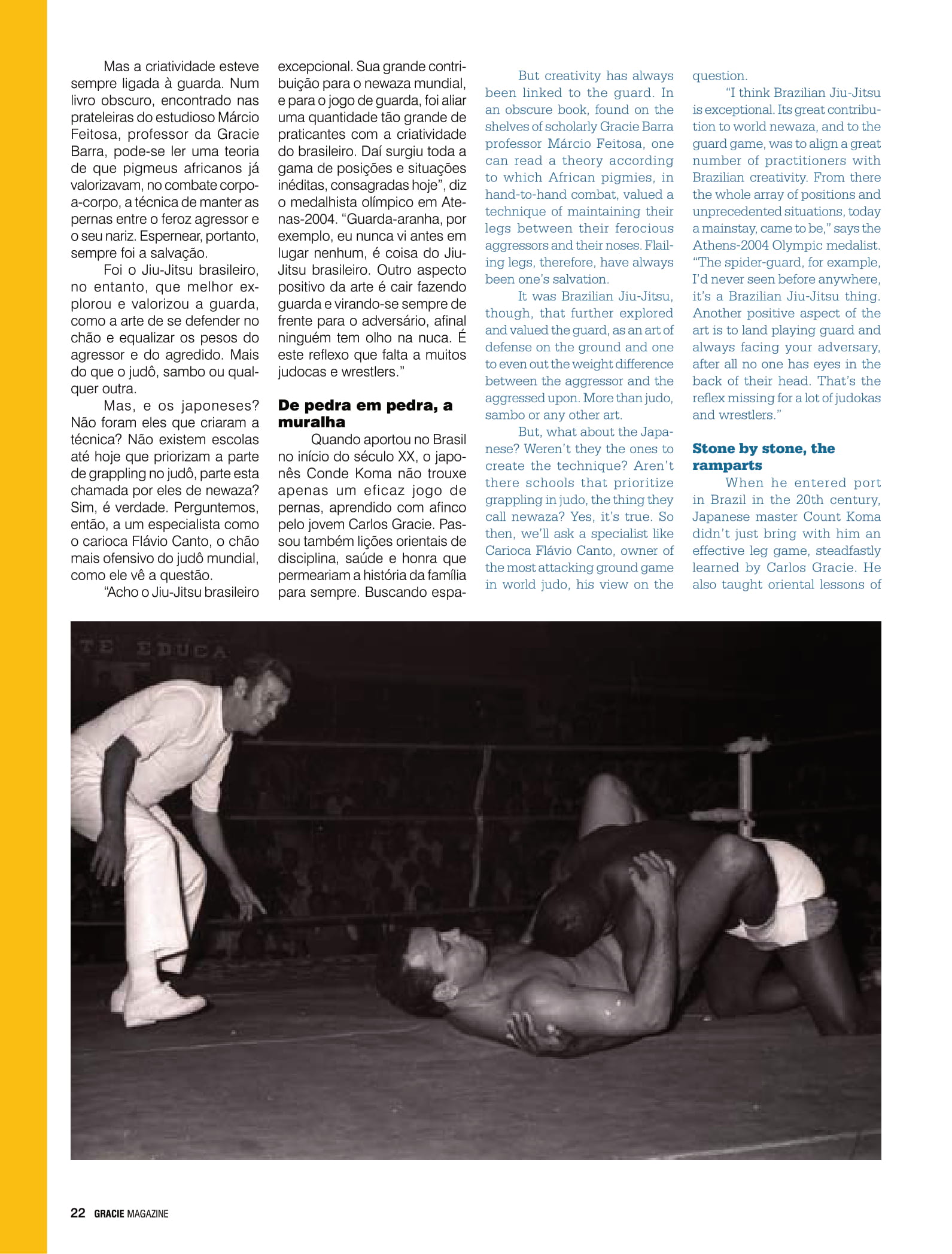
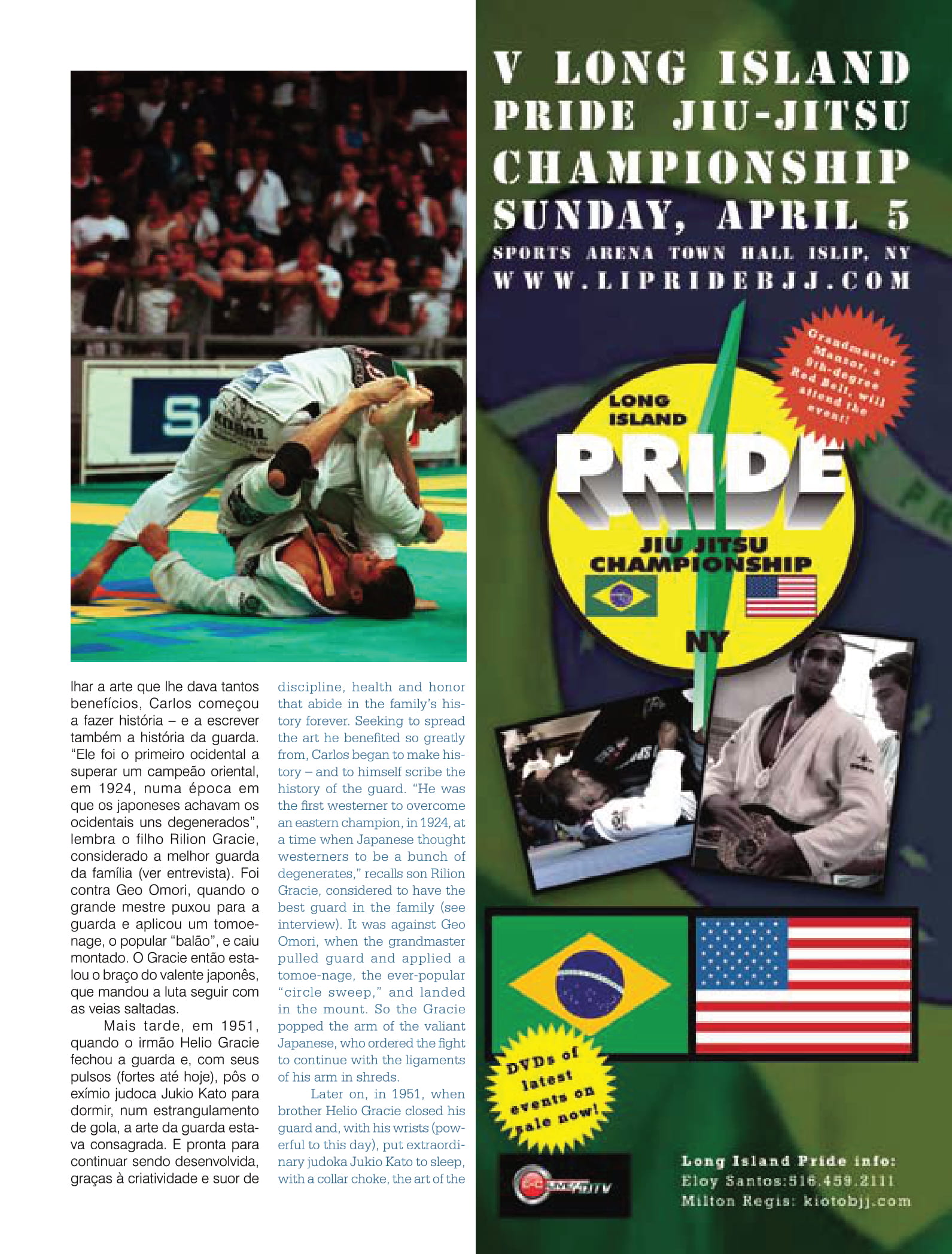
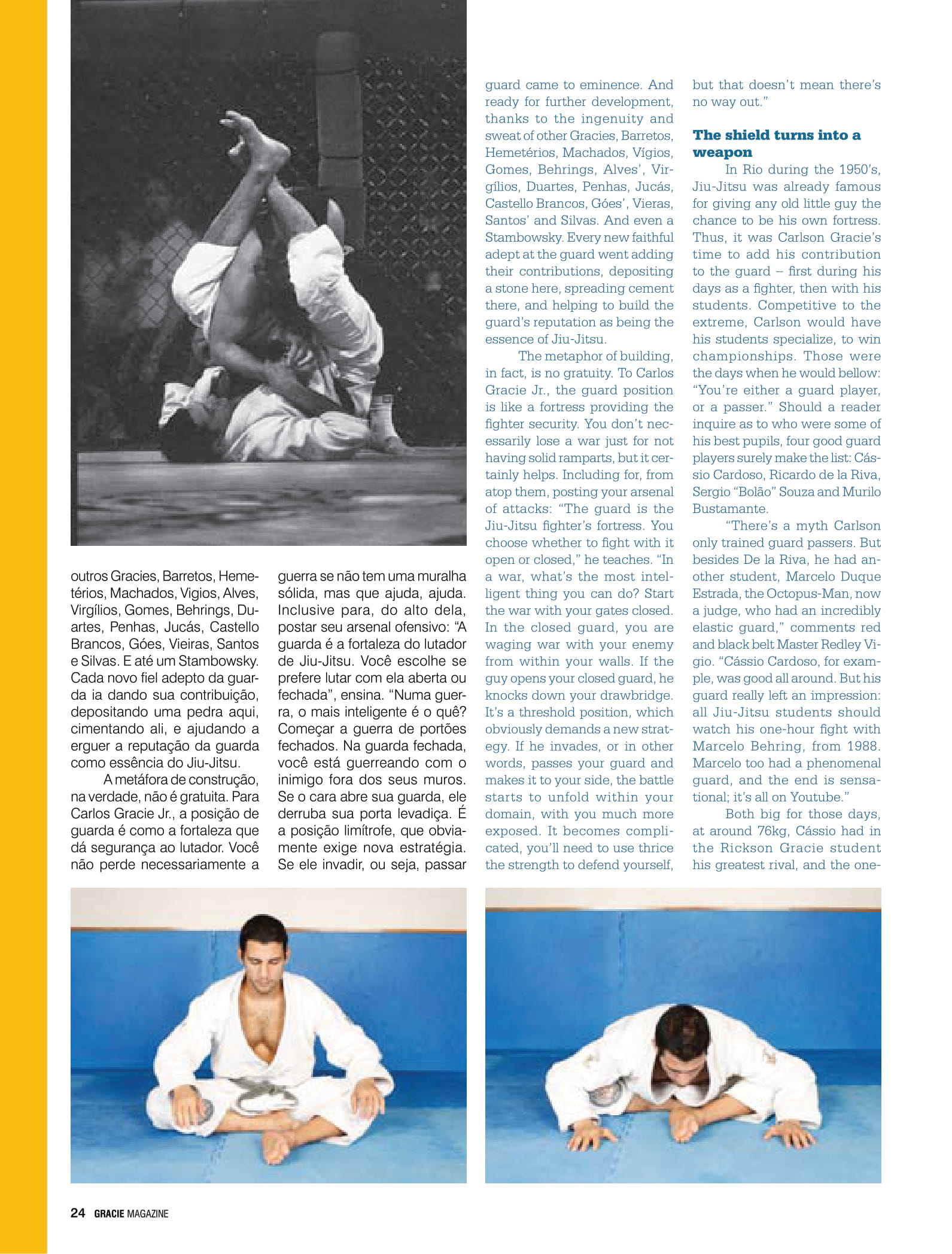
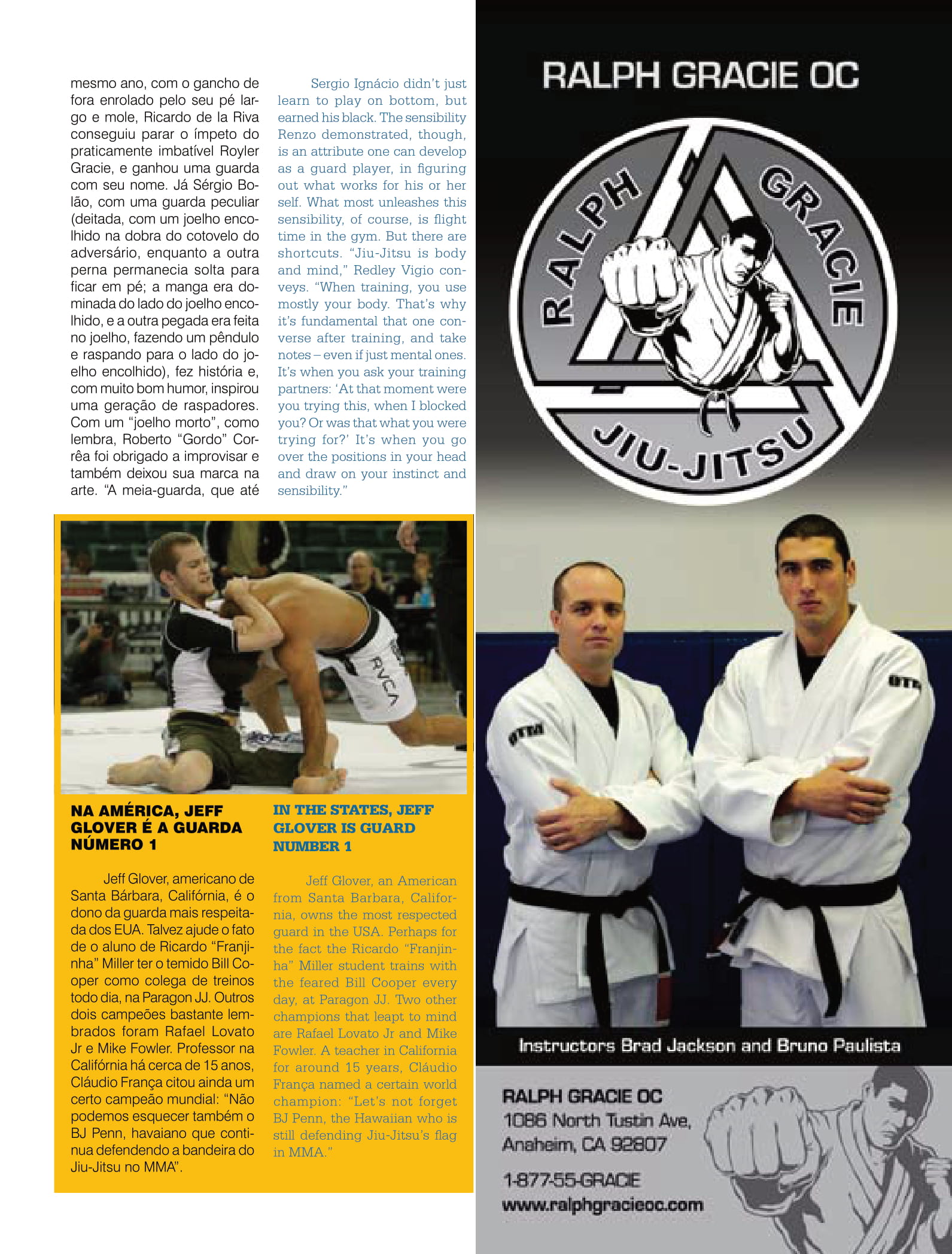
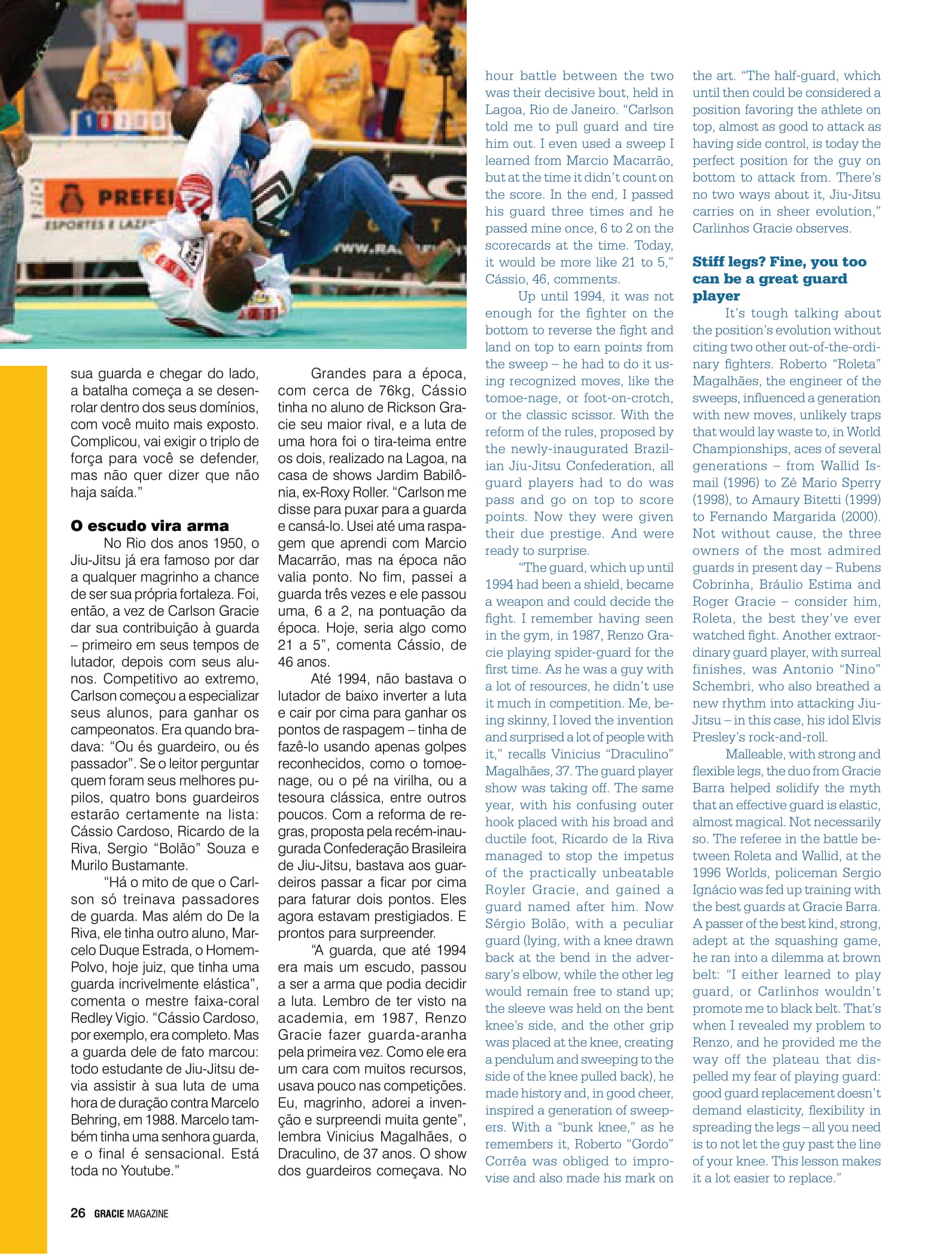
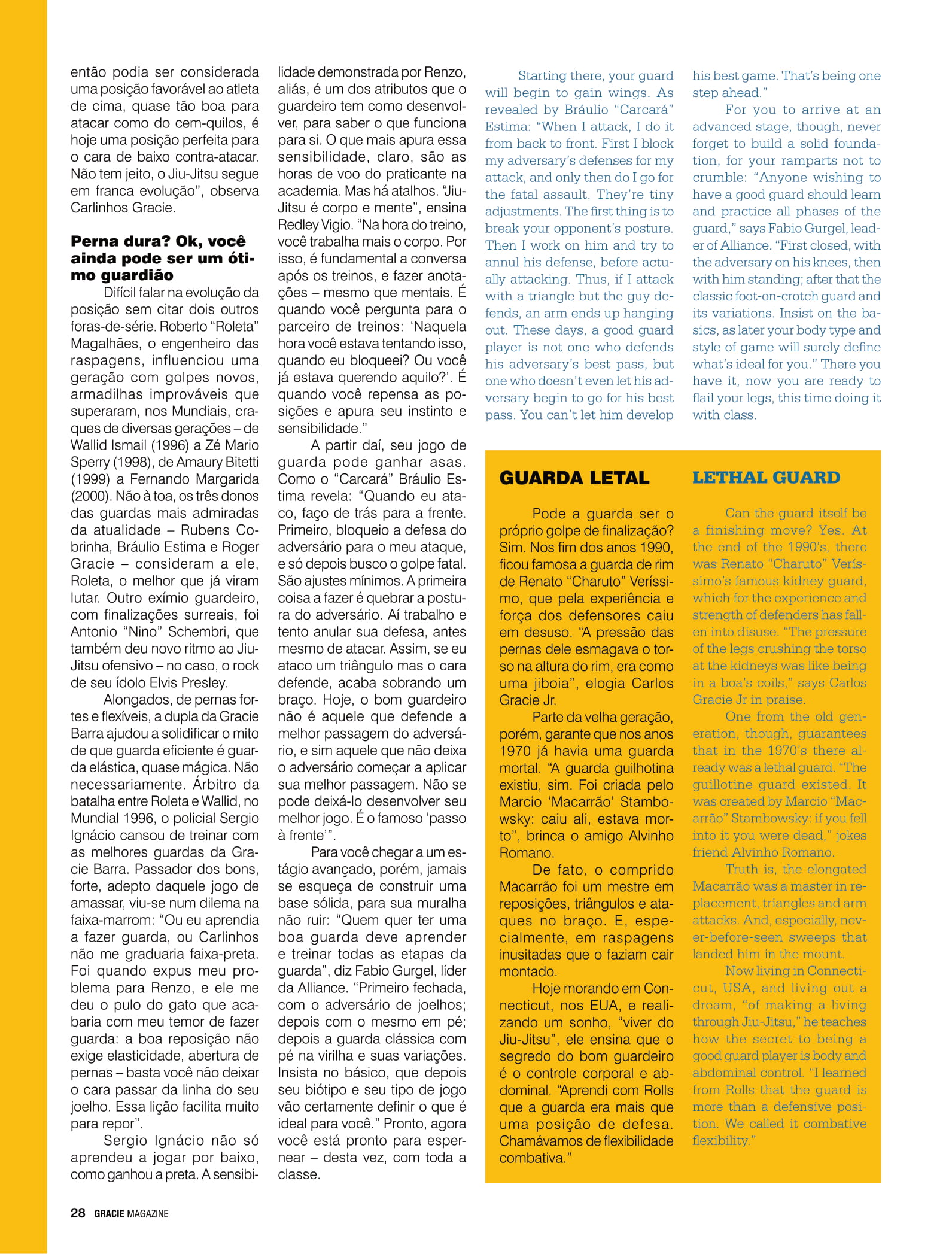
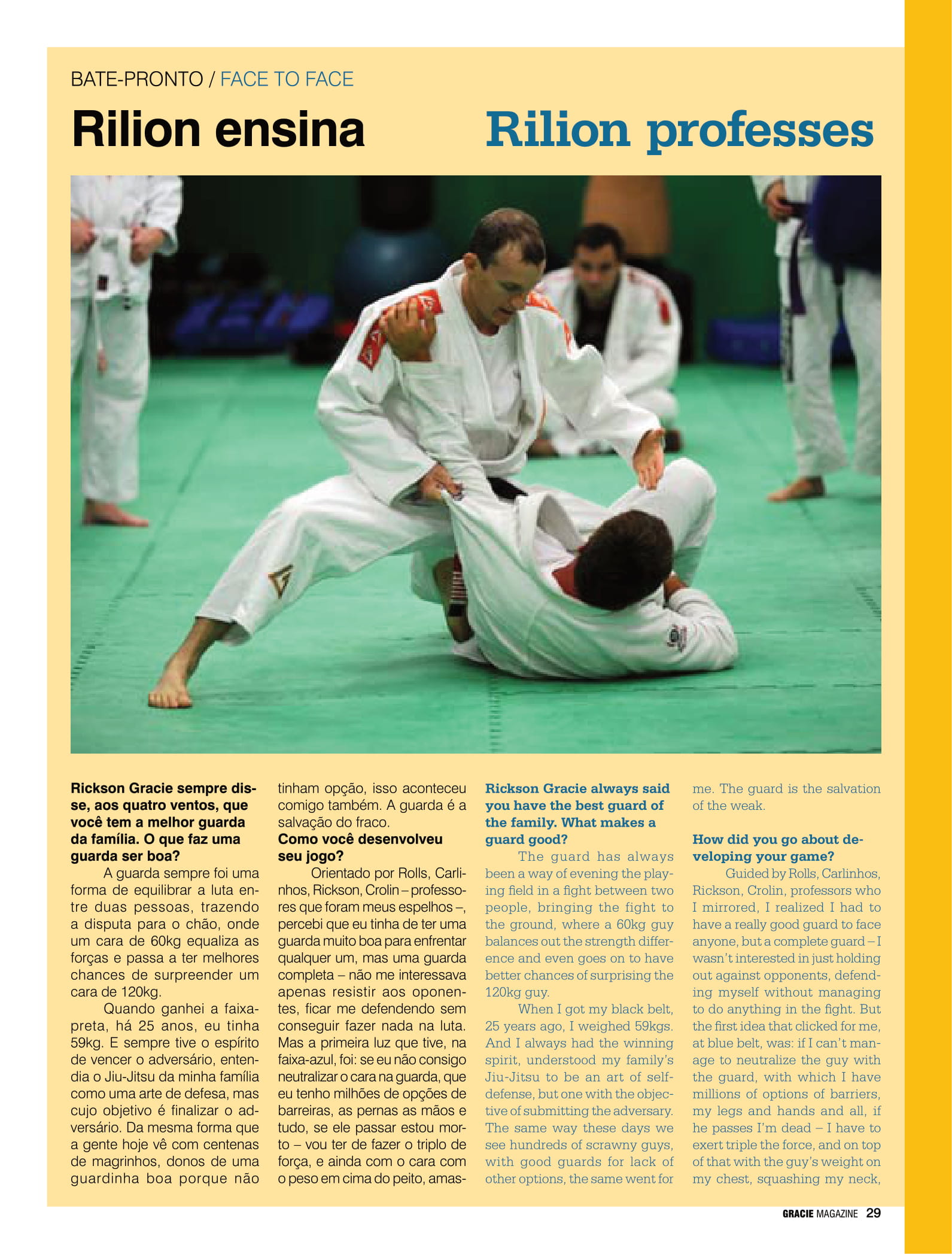
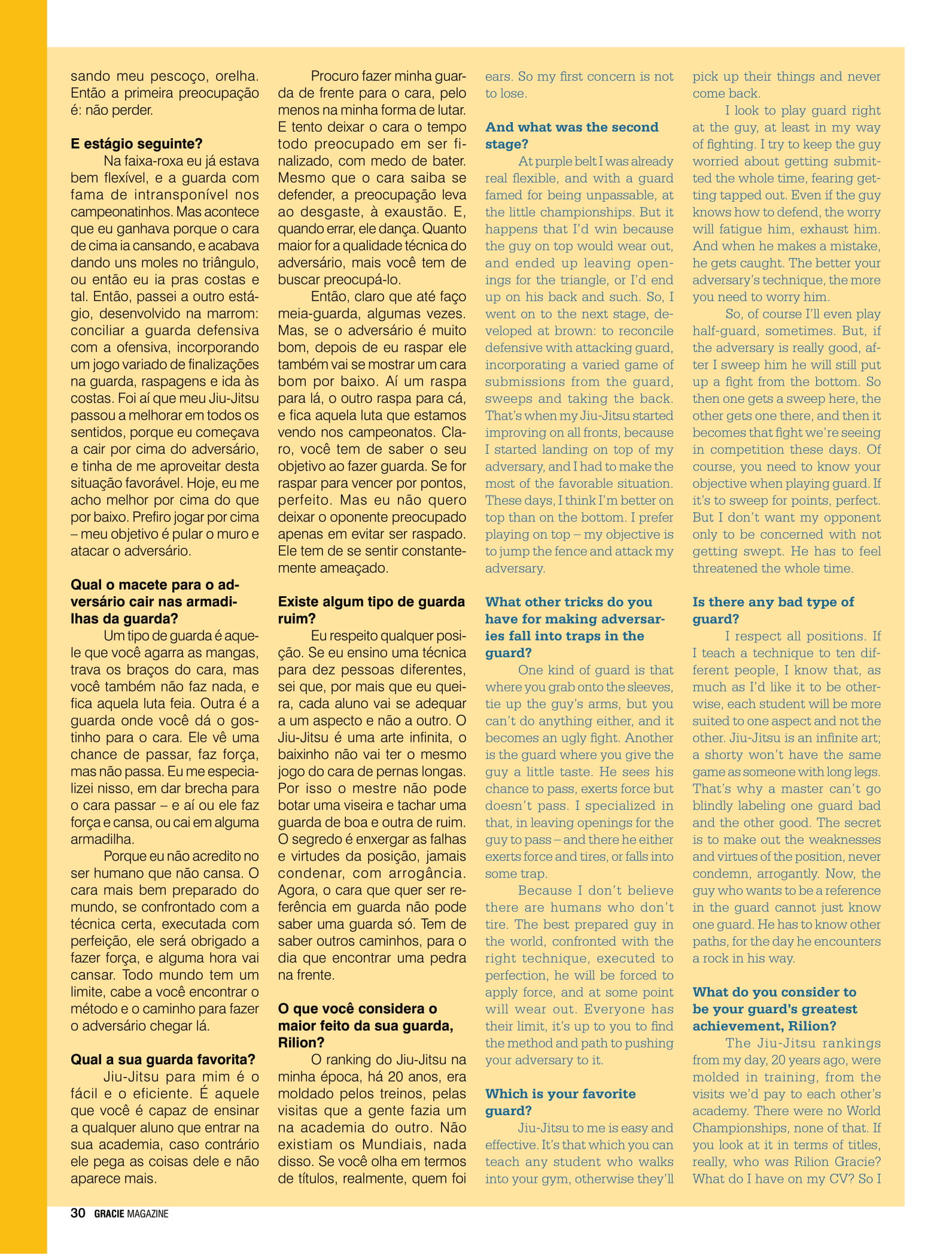
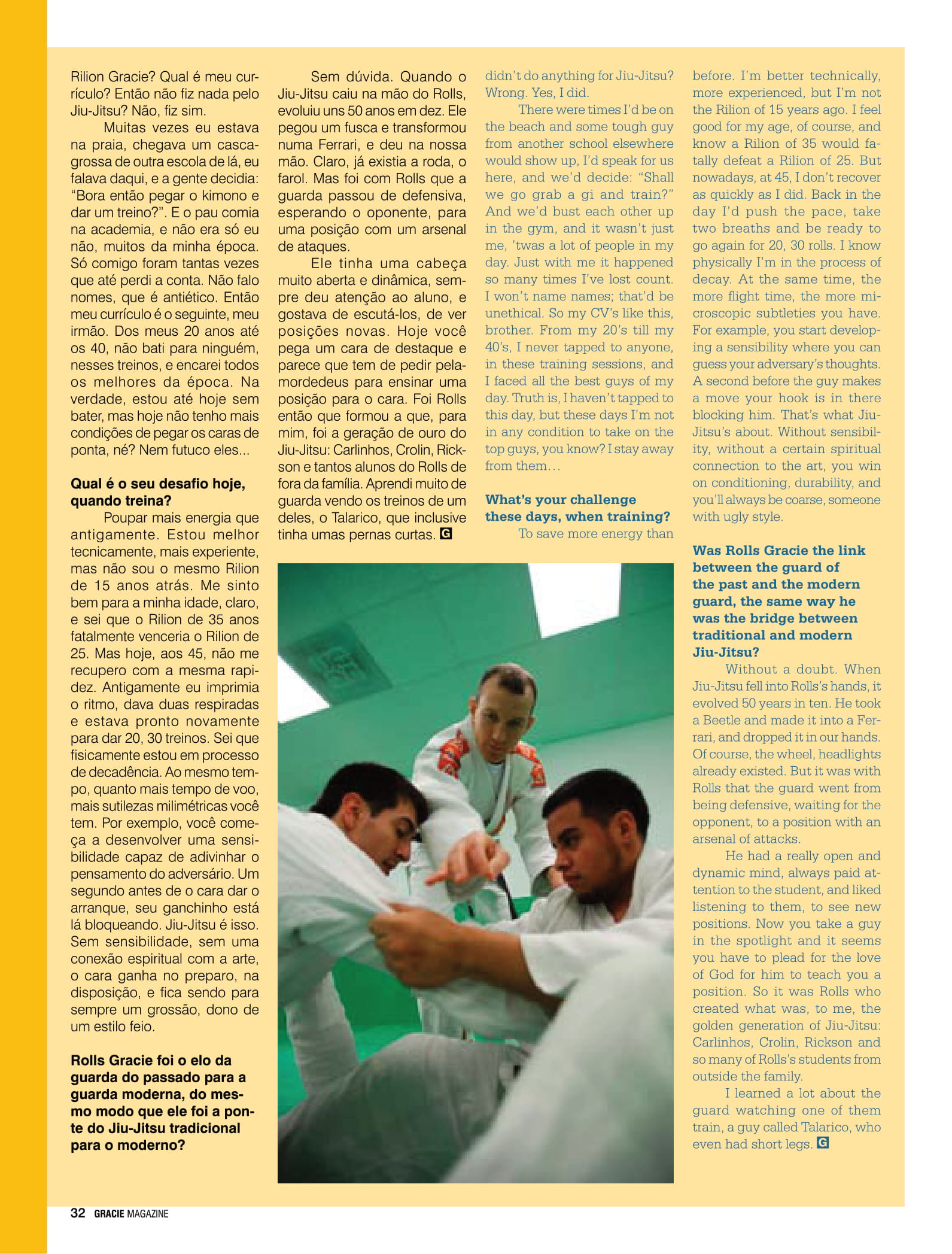
Yes, you don’t remember it, but you were born playing guard. If you stopped practicing it for awhile that’s your doing. After all, the position,
Jiu-Jitsu fighters’ eternal savior in the ring, has been
around for ages. Years. Centuries. Anyone to peer at
the oil-painting masterpiece “Fight at the Cock Inn,” by
Francisco Goya, can observe the following scene: a bar
fight, Spaniards beating each other with clubs all over the
place. At center canvas, a guy seems to have a superior
position… passing the guard! Well, you may need a little
imagination to see that.
But creativity has always
been linked to the guard. In
an obscure book, found on the
shelves of scholarly Gracie Barra
professor Márcio Feitosa, one
can read a theory according
to which African pigmies, in
hand-to-hand combat, valued a
technique of maintaining their
legs between their ferocious
aggressors and their noses. Flailing legs, therefore, have always
been one’s salvation.
It was Brazilian Jiu-Jitsu,
though, that further explored
and valued the guard, as an art of
defense on the ground and one
to even out the weight difference
between the aggressor and the
aggressed upon. More than judo,
sambo or any other art.
But, what about the Japanese? Weren’t they the ones to
create the technique? Aren’t
there schools that prioritize
grappling in judo, the thing they
call newaza? Yes, it’s true. So
then, we’ll ask a specialist like
Carioca Flávio Canto, owner of
the most attacking ground game
in world judo, his view on the
question.
“I think Brazilian Jiu-Jitsu
is exceptional. Its great contribution to world newaza, and to the
guard game, was to align a great
number of practitioners with
Brazilian creativity. From there
the whole array of positions and
unprecedented situations, today
a mainstay, came to be,” says the
Athens-2004 Olympic medalist.
“The spider-guard, for example,
I’d never seen before anywhere,
it’s a Brazilian Jiu-Jitsu thing.
Another positive aspect of the
art is to land playing guard and
always facing your adversary,
after all no one has eyes in the
back of their head. That’s the
reflex missing for a lot of judokas
and wrestlers.”
Stone by stone, the
ramparts
When he entered port
in Brazil in the 20th century,
Japanese master Count Koma
didn’t just bring with him an
effective leg game, steadfastly
learned by Carlos Gracie. He
also taught oriental lessons of
discipline, health and honor
that abide in the family’s history forever. Seeking to spread
the art he benefited so greatly
from, Carlos began to make history – and to himself scribe the
history of the guard. “He was
the first westerner to overcome
an eastern champion, in 1924, at
a time when Japanese thought
westerners to be a bunch of
degenerates,” recalls son Rilion
Gracie, considered to have the
best guard in the family (see
interview). It was against Geo
Omori, when the grandmaster
pulled guard and applied a
tomoe-nage, the ever-popular
“circle sweep,” and landed
in the mount. So the Gracie
popped the arm of the valiant
Japanese, who ordered the fight
to continue with the ligaments
of his arm in shreds.
Later on, in 1951, when
brother Helio Gracie closed his
guard and, with his wrists (powerful to this day), put extraordinary judoka Jukio Kato to sleep,
with a collar choke, the art of the
guard came to eminence. And
ready for further development,
thanks to the ingenuity and
sweat of other Gracies, Barretos,
Hemetérios, Machados, Vígios,
Gomes, Behrings, Alves’, Virgílios, Duartes, Penhas, Jucás,
Castello Brancos, Góes’, Vieras,
Santos’ and Silvas. And even a
Stambowsky. Every new faithful
adept at the guard went adding
their contributions, depositing
a stone here, spreading cement
there, and helping to build the
guard’s reputation as being the
essence of Jiu-Jitsu.
The metaphor of building,
in fact, is no gratuity. To Carlos
Gracie Jr., the guard position
is like a fortress providing the
fighter security. You don’t necessarily lose a war just for not
having solid ramparts, but it certainly helps. Including for, from
atop them, posting your arsenal
of attacks: “The guard is the
Jiu-Jitsu fighter’s fortress. You
choose whether to fight with it
open or closed,” he teaches. “In
a war, what’s the most intelligent thing you can do? Start
the war with your gates closed.
In the closed guard, you are
waging war with your enemy
from within your walls. If the
guy opens your closed guard, he
knocks down your drawbridge.
It’s a threshold position, which
obviously demands a new strategy. If he invades, or in other
words, passes your guard and
makes it to your side, the battle
starts to unfold within your
domain, with you much more
exposed. It becomes complicated, you’ll need to use thrice
the strength to defend yourself,
but that doesn’t mean there’s
no way out.”
The shield turns into a
weapon
In Rio during the 1950’s,
Jiu-Jitsu was already famous
for giving any old little guy the
chance to be his own fortress.
Thus, it was Carlson Gracie’s
time to add his contribution
to the guard – first during his
days as a fighter, then with his
students. Competitive to the
extreme, Carlson would have
his students specialize, to win
championships. Those were
the days when he would bellow:
“You’re either a guard player,
or a passer.” Should a reader
inquire as to who were some of
his best pupils, four good guard
players surely make the list: Cássio Cardoso, Ricardo de la Riva,
Sergio “Bolão” Souza and Murilo
Bustamante.
“There’s a myth Carlson
only trained guard passers. But
besides De la Riva, he had another student, Marcelo Duque
Estrada, the Octopus-Man, now
a judge, who had an incredibly
elastic guard,” comments red
and black belt Master Redley Vigio. “Cássio Cardoso, for example, was good all around. But his
guard really left an impression:
all Jiu-Jitsu students should
watch his one-hour fight with
Marcelo Behring, from 1988.
Marcelo too had a phenomenal
guard, and the end is sensational; it’s all on Youtube.”
Both big for those days,
at around 76kg, Cássio had in
the Rickson Gracie student
his greatest rival, and the one-
hour battle between the two
was their decisive bout, held in
Lagoa, Rio de Janeiro. “Carlson
told me to pull guard and tire
him out. I even used a sweep I
learned from Marcio Macarrão,
but at the time it didn’t count on
the score. In the end, I passed
his guard three times and he
passed mine once, 6 to 2 on the
scorecards at the time. Today,
it would be more like 21 to 5,”
Cássio, 46, comments.
Up until 1994, it was not
enough for the fighter on the
bottom to reverse the fight and
land on top to earn points from
the sweep – he had to do it using recognized moves, like the
tomoe-nage, or foot-on-crotch,
or the classic scissor. With the
reform of the rules, proposed by
the newly-inaugurated Brazilian Jiu-Jitsu Confederation, all
guard players had to do was
pass and go on top to score
points. Now they were given
their due prestige. And were
ready to surprise.
“The guard, which up until
1994 had been a shield, became
a weapon and could decide the
fight. I remember having seen
in the gym, in 1987, Renzo Gracie playing spider-guard for the
first time. As he was a guy with
a lot of resources, he didn’t use
it much in competition. Me, being skinny, I loved the invention
and surprised a lot of people with
it,” recalls Vinicius “Draculino”
Magalhães, 37. The guard player
show was taking off. The same
year, with his confusing outer
hook placed with his broad and
ductile foot, Ricardo de la Riva
managed to stop the impetus
of the practically unbeatable
Royler Gracie, and gained a
guard named after him. Now
Sérgio Bolão, with a peculiar
guard (lying, with a knee drawn
back at the bend in the adversary’s elbow, while the other leg
would remain free to stand up;
the sleeve was held on the bent
knee’s side, and the other grip
was placed at the knee, creating
a pendulum and sweeping to the
side of the knee pulled back), he
made history and, in good cheer,
inspired a generation of sweepers. With a “bunk knee,” as he
remembers it, Roberto “Gordo”
Corrêa was obliged to improvise and also made his mark on
the art. “The half-guard, which
until then could be considered a
position favoring the athlete on
top, almost as good to attack as
having side control, is today the
perfect position for the guy on
bottom to attack from. There’s
no two ways about it, Jiu-Jitsu
carries on in sheer evolution,”
Carlinhos Gracie observes.
Stiff legs? fine, you too
can be a great guard
player
It’s tough talking about
the position’s evolution without
citing two other out-of-the-ordinary fighters. Roberto “Roleta”
Magalhães, the engineer of the
sweeps, influenced a generation
with new moves, unlikely traps
that would lay waste to, in World
Championships, aces of several
generations – from Wallid Ismail (1996) to Zé Mario Sperry
(1998), to Amaury Bitetti (1999)
to Fernando Margarida (2000).
Not without cause, the three
owners of the most admired
guards in present day – Rubens
Cobrinha, Bráulio Estima and
Roger Gracie – consider him,
Roleta, the best they’ve ever
watched fight. Another extraordinary guard player, with surreal
finishes, was Antonio “Nino”
Schembri, who also breathed a
new rhythm into attacking JiuJitsu – in this case, his idol Elvis
Presley’s rock-and-roll.
Malleable, with strong and
flexible legs, the duo from Gracie
Barra helped solidify the myth
that an effective guard is elastic,
almost magical. Not necessarily
so. The referee in the battle between Roleta and Wallid, at the
1996 Worlds, policeman Sergio
Ignácio was fed up training with
the best guards at Gracie Barra.
A passer of the best kind, strong,
adept at the squashing game,
he ran into a dilemma at brown
belt: “I either learned to play
guard, or Carlinhos wouldn’t
promote me to black belt. That’s
when I revealed my problem to
Renzo, and he provided me the
way off the plateau that dispelled my fear of playing guard:
good guard replacement doesn’t
demand elasticity, flexibility in
spreading the legs – all you need
is to not let the guy past the line
of your knee. This lesson makes
it a lot easier to replace.”
Starting there, your guard
will begin to gain wings. As
revealed by Bráulio “Carcará”
Estima: “When I attack, I do it
from back to front. First I block
my adversary’s defenses for my
attack, and only then do I go for
the fatal assault. They’re tiny
adjustments. The first thing is to
break your opponent’s posture.
Then I work on him and try to
annul his defense, before actually attacking. Thus, if I attack
with a triangle but the guy defends, an arm ends up hanging
out. These days, a good guard
player is not one who defends
his adversary’s best pass, but
one who doesn’t even let his adversary begin to go for his best
pass. You can’t let him develop
his best game. That’s being one
step ahead.”
For you to arrive at an
advanced stage, though, never
forget to build a solid foundation, for your ramparts not to
crumble: “Anyone wishing to
have a good guard should learn
and practice all phases of the
guard,” says Fabio Gurgel, leader of Alliance. “First closed, with
the adversary on his knees, then
with him standing; after that the
classic foot-on-crotch guard and
its variations. Insist on the basics, as later your body type and
style of game will surely define
what’s ideal for you.” There you
have it, now you are ready to
flail your legs, this time doing it
with class.
===
Sergio Ignácio didn’t just
learn to play on bottom, but
earned his black. The sensibility
Renzo demonstrated, though,
is an attribute one can develop
as a guard player, in figuring
out what works for his or her
self. What most unleashes this
sensibility, of course, is flight
time in the gym. But there are
shortcuts. “Jiu-Jitsu is body
and mind,” Redley Vigio conveys. “When training, you use
mostly your body. That’s why
it’s fundamental that one converse after training, and take
notes – even if just mental ones.
It’s when you ask your training
partners: ‘At that moment were
you trying this, when I blocked
you? Or was that what you were
trying for?’ It’s when you go
over the positions in your head
and draw on your instinct and
sensibility.”
===
In the States, Jeff Glover is guard
number 1
Jeff Glover, an American
from Santa Barbara, California, owns the most respected
guard in the USA. Perhaps for
the fact the Ricardo “Franjinha” Miller student trains with
the feared Bill Cooper every
day, at Paragon JJ. Two other
champions that leapt to mind
are Rafael Lovato Jr and Mike
Fowler. A teacher in California
for around 15 years, Cláudio
França named a certain world
champion: “Let’s not forget
BJ Penn, the Hawaiian who is
still defending Jiu-Jitsu’s flag
in MMA.”
===
Lethal Guard
Can the guard itself be
a finishing move? Yes. At
the end of the 1990’s, there
was Renato “Charuto” Veríssimo’s famous kidney guard,
which for the experience and
strength of defenders has fallen into disuse. “The pressure
of the legs crushing the torso
at the kidneys was like being
in a boa’s coils,” says Carlos
Gracie Jr in praise.
One from the old generation, though, guarantees
that in the 1970’s there already was a lethal guard. “The
guillotine guard existed. It
was created by Marcio “Macarrão” Stambowsky: if you fell
into it you were dead,” jokes
friend Alvinho Romano.
Truth is, the elongated
Macarrão was a master in replacement, triangles and arm
attacks. And, especially, never-before-seen sweeps that
landed him in the mount.
Now living in Connecticut, USA, and living out a
dream, “of making a living
through Jiu-Jitsu,” he teaches
how the secret to being a
good guard player is body and
abdominal control. “I learned
from Rolls that the guard is
more than a defensive position. We called it combative
flexibility.”
===
Rilion professes
Rickson Gracie always said
you have the best guard of
the family. What makes a
guard good?
The guard has always
been a way of evening the playing field in a fight between two
people, bringing the fight to
the ground, where a 60kg guy
balances out the strength difference and even goes on to have
better chances of surprising the
120kg guy.
When I got my black belt,
25 years ago, I weighed 59kgs.
And I always had the winning
spirit, understood my family’s
Jiu-Jitsu to be an art of selfdefense, but one with the objective of submitting the adversary.
The same way these days we
see hundreds of scrawny guys,
with good guards for lack of
other options, the same went for
me. The guard is the salvation
of the weak.
How did you go about developing your game?
Guided by Rolls, Carlinhos,
Rickson, Crolin, professors who
I mirrored, I realized I had to
have a really good guard to face
anyone, but a complete guard – I
wasn’t interested in just holding
out against opponents, defending myself without managing
to do anything in the fight. But
the first idea that clicked for me,
at blue belt, was: if I can’t manage to neutralize the guy with
the guard, with which I have
millions of options of barriers,
my legs and hands and all, if
he passes I’m dead – I have to
exert triple the force, and on top
of that with the guy’s weight on
my chest, squashing my neck
ears. So my first concern is not
to lose.
And what was the second
stage?
At purple belt I was already
real flexible, and with a guard
famed for being unpassable, at
the little championships. But it
happens that I’d win because
the guy on top would wear out,
and ended up leaving openings for the triangle, or I’d end
up on his back and such. So, I
went on to the next stage, developed at brown: to reconcile
defensive with attacking guard,
incorporating a varied game of
submissions from the guard,
sweeps and taking the back.
That’s when my Jiu-Jitsu started
improving on all fronts, because
I started landing on top of my
adversary, and I had to make the
most of the favorable situation.
These days, I think I’m better on
top than on the bottom. I prefer
playing on top – my objective is
to jump the fence and attack my
adversary.
What other tricks do you
have for making adversaries fall into traps in the
guard?
One kind of guard is that
where you grab onto the sleeves,
tie up the guy’s arms, but you
can’t do anything either, and it
becomes an ugly fight. Another
is the guard where you give the
guy a little taste. He sees his
chance to pass, exerts force but
doesn’t pass. I specialized in
that, in leaving openings for the
guy to pass – and there he either
exerts force and tires, or falls into
some trap.
Because I don’t believe
there are humans who don’t
tire. The best prepared guy in
the world, confronted with the
right technique, executed to
perfection, he will be forced to
apply force, and at some point
will wear out. Everyone has
their limit, it’s up to you to find
the method and path to pushing
your adversary to it.
Which is your favorite
guard?
Jiu-Jitsu to me is easy and
effective. It’s that which you can
teach any student who walks
into your gym, otherwise they’ll
pick up their things and never
come back.
I look to play guard right
at the guy, at least in my way
of fighting. I try to keep the guy
worried about getting submitted the whole time, fearing getting tapped out. Even if the guy
knows how to defend, the worry
will fatigue him, exhaust him.
And when he makes a mistake,
he gets caught. The better your
adversary’s technique, the more
you need to worry him.
So, of course I’ll even play
half-guard, sometimes. But, if
the adversary is really good, after I sweep him he will still put
up a fight from the bottom. So
then one gets a sweep here, the
other gets one there, and then it
becomes that fight we’re seeing
in competition these days. Of
course, you need to know your
objective when playing guard. If
it’s to sweep for points, perfect.
But I don’t want my opponent
only to be concerned with not
getting swept. He has to feel
threatened the whole time.
Is there any bad type of
guard?
I respect all positions. If
I teach a technique to ten different people, I know that, as
much as I’d like it to be otherwise, each student will be more
suited to one aspect and not the
other. Jiu-Jitsu is an infinite art;
a shorty won’t have the same
game as someone with long legs.
That’s why a master can’t go
blindly labeling one guard bad
and the other good. The secret
is to make out the weaknesses
and virtues of the position, never
condemn, arrogantly. Now, the
guy who wants to be a reference
in the guard cannot just know
one guard. He has to know other
paths, for the day he encounters
a rock in his way.
What do you consider to
be your guard’s greatest
achievement, Rilion?
The Jiu-Jitsu rankings
from my day, 20 years ago, were
molded in training, from the
visits we’d pay to each other’s
academy. There were no World
Championships, none of that. If
you look at it in terms of titles,
really, who was Rilion Gracie?
What do I have on my CV? So I
didn’t do anything for Jiu-Jitsu?
Wrong. Yes, I did.
There were times I’d be on
the beach and some tough guy
from another school elsewhere
would show up, I’d speak for us
here, and we’d decide: “Shall
we go grab a gi and train?”
And we’d bust each other up
in the gym, and it wasn’t just
me, ’twas a lot of people in my
day. Just with me it happened
so many times I’ve lost count.
I won’t name names; that’d be
unethical. So my CV’s like this,
brother. From my 20’s till my
40’s, I never tapped to anyone,
in these training sessions, and
I faced all the best guys of my
day. Truth is, I haven’t tapped to
this day, but these days I’m not
in any condition to take on the
top guys, you know? I stay away
from them…
What’s your challenge
these days, when training?
To save more energy than
before. I’m better technically,
more experienced, but I’m not
the Rilion of 15 years ago. I feel
good for my age, of course, and
know a Rilion of 35 would fatally defeat a Rilion of 25. But
nowadays, at 45, I don’t recover
as quickly as I did. Back in the
day I’d push the pace, take
two breaths and be ready to
go again for 20, 30 rolls. I know
physically I’m in the process of
decay. At the same time, the
more flight time, the more microscopic subtleties you have.
For example, you start developing a sensibility where you can
guess your adversary’s thoughts.
A second before the guy makes
a move your hook is in there
blocking him. That’s what JiuJitsu’s about. Without sensibility, without a certain spiritual
connection to the art, you win
on conditioning, durability, and
you’ll always be coarse, someone
with ugly style.
Was Rolls Gracie the link
between the guard of
the past and the modern
guard, the same way he
was the bridge between
traditional and modern
Jiu-Jitsu?
Without a doubt. When
Jiu-Jitsu fell into Rolls’s hands, it
evolved 50 years in ten. He took
a Beetle and made it into a Ferrari, and dropped it in our hands.
Of course, the wheel, headlights
already existed. But it was with
Rolls that the guard went from
being defensive, waiting for the
opponent, to a position with an
arsenal of attacks.
He had a really open and
dynamic mind, always paid attention to the student, and liked
listening to them, to see new
positions. Now you take a guy
in the spotlight and it seems
you have to plead for the love
of God for him to teach you a
position. So it was Rolls who
created what was, to me, the
golden generation of Jiu-Jitsu:
Carlinhos, Crolin, Rickson and
so many of Rolls’s students from
outside the family.
I learned a lot about the
guard watching one of them
train, a guy called Talarico, who
even had short legs.



